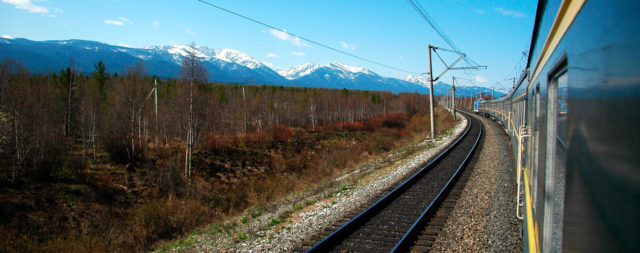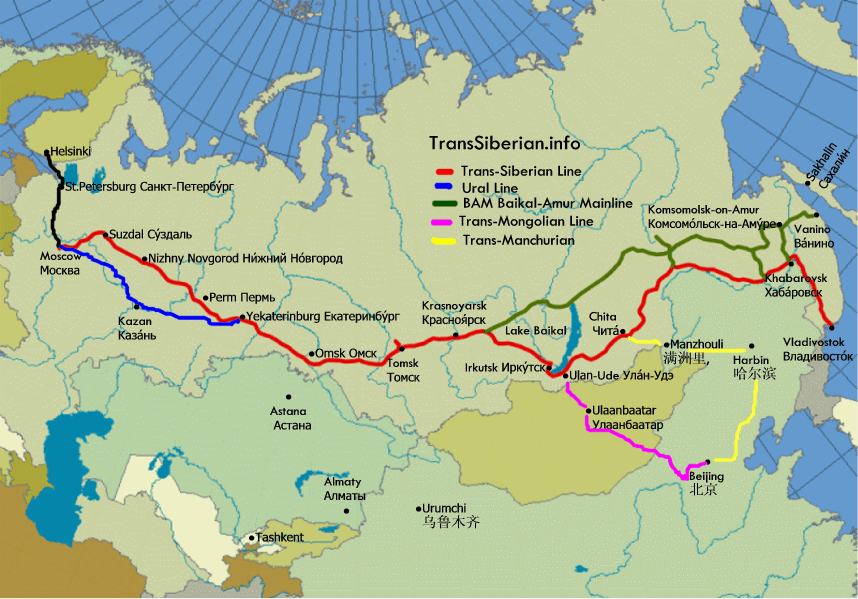
The End of the Line for the Trans-Siberian Railroad?
Publication: Eurasia Daily Monitor Volume: 13 Issue: 159
By:

October 2016 marks the centennial of the completion of the Trans-Siberian Railroad (Trans-Sib), Russia and the world’s longest railroad line. Yet, no special celebrations are planned—in part due to Russia’s current economic difficulties, but also because that fabled railroad may be reaching the end of its usable life. In recent decades, the Trans-Siberia rail line was done in by corruption, the lack of a reliable legal culture in Russia, and the emergence of less expensive and more reliable alternative transportation networks between Asia and Europe.
The absence of any commemoration of the Trans-Sib anniversary is striking given Russians’ penchant for marking almost any “round” anniversary. But even more significant is that on this anniversary, the Russian authorities have announced they are putting off plans to reconstruct both the Trans-Sib and the related Baikal-Amur Mainline (BAM) railroad for another year. More surprising still, some Russian commentators are saying that spending on either would be throwing good money after bad because these lines will never carry the amount of cargo and number of passengers Moscow has long insisted they are capable of (Versia.ru, October 3).

If Russian authorities indeed give up on upgrading the railway infrastructure in the Far East—either because they conclude that such pessimistic projections are accurate or because they have no ability to do otherwise—Moscow will lose much of its ability to project power in the Asia-Pacific and potentially even to control the Russian Far East. It will thus be marginalized by China and Japan, on the one hand, and Europe, on the other, in the burgeoning trade between the two. And that, in turn, will boost the incomes and status of other countries through which this trade will pass, leading ever more of them to turn away from Moscow and look toward Beijing and Berlin instead.
Some of the reasons for the declining prospects of the Trans-Sib are not of Russia’s making: Global warming has made the northern sea route potentially more attractive, especially since Chinese ships have been able to make the passage this year in about half the number of days needed for sea vessels to sail from Shanghai to Europe. And ocean-going shipping more generally has become a more attractive option because of containerization. But most of the problems the Trans-Sib now faces are Russia’s fault—problems that have only made the alternatives of rail lines through Central Asia and the Caucasus as well as ocean shipping more attractive to Asia-Pacific countries (Turkist.org, September 29; Svpressa.ru, October 4).
Investigative paper Versiya’s Dmitry Zlobin says that ever more analysts in Moscow are expressing their doubts about the utility of rebuilding the Trans-Sib line but also of supporting Russian Railways itself—although the company places the blame on others in the Russian economy. The company says that Russian ports are inadequate to handle goods that might be put on Trans-Sib trains and that Russian roads are inadequate to transport raw materials and goods to the railroad line in the first place (Versia.ru, October 3).
Nonetheless, the Verisya analyst points out that Russian Railways is a big part of the problem. In March of this year, the Russian Accounting Chamber discovered that Russian Railways had spent only 3.7 billion of the 50 billion rubles ($600,000 out of $800 million) it had been given for rebuilding the Trans-Sib and other rail lines in Siberia. The rest it put out at interest, apparently deciding that was a more profitable venture than rebuilding the railways as it was supposed to. As a result, investigators found that no work had been done at 30 of the 88 sites where it had been scheduled.
And the situation with regard to the company is even worse: The Western accounting firm Deloitte found that Russia could easily spend 45 percent less than it is budgeting for rebuilding BAM and the Trans-Sib if it adopted normal budgeting procedures and if so much of its funding was not siphoned off by various corrupt schemes. Deloitte’s concerns were echoed by Mikhail Abyzov, the Russian Federation’s minister for open government, who recently suggested the entire economic model that Russian Railways was using was defective.
More seriously, Abyzov has said that “the modernization of BAM and the Trans-Sib are of course a government goal and therefore very important, but they do not have any relationship to the development of the Russian Far East” in their current form. That is because the rail lines are not connected to the places where people live and factories operate. Until that changes, putting money into the railroads will not earn much return, the minister pointed out (Versia.ru, October 3).
Still bigger problems lie elsewhere, Zlobin suggests. Foreign countries mistrust Russia’s tax and customs regimes because the country’s court system does not work. Additionally, even those who need to ship goods quickly—the Trans-Sib’s biggest selling point—do not believe Moscow can deliver the goods in a timely manner. Because of problems with the line, goods now move along it at a rate of 27 kilometers an hour, faster than an ocean-going ship but far slower than the 100 kilometers per hour that goods move along Chinese and Japanese rail routes that bypass Russia. They do not move at multiples of that speed, as Moscow has claimed.
Simply replacing the old rail bed or the trains themselves will not solve these problems, various experts say. Analyst Dmitry Verkhoturov, for one, argues that regardless of what Moscow does, it will not succeed in making the Trans-Sib “the main Euro-Asian transport artery.” Given that fact, he suggests, it may simply be best to invest money elsewhere and let what was long billed as the greatest rail route in the world fade into the past (Verkhoturov.info, October 22, 2012).



